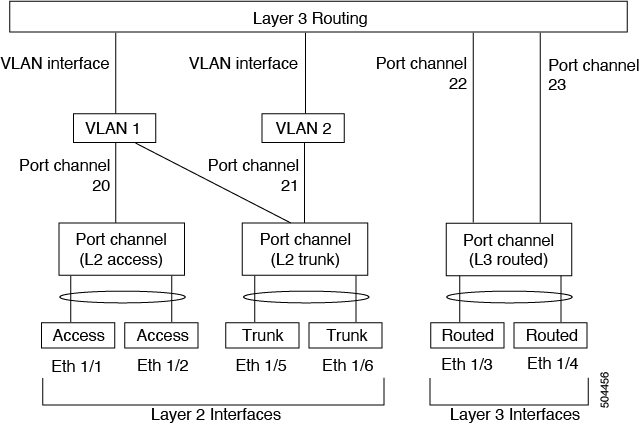About Port Channels
A port channel is an aggregation of multiple physical interfaces that creates a logical interface. You can bundle up to 8 individual active links into a port channel to provide increased bandwidth and redundancy. Port channeling also load balances traffic across these physical interfaces. The port channel stays operational as long as at least one physical interface within the port channel is operational.
A port channel is an aggregation of multiple physical interfaces that creates a logical interface. You can bundle up to 4 individual active links into a port channel to provide increased bandwidth and redundancy. Port channeling also load balances traffic across these physical interfaces. The port channel stays operational as long as at least one physical interface within the port channel is operational.
The allowed system wide limit for maximum port channel is 24. There are 6 port groups with each port group containing 8 ports. You can create a maximum of 4 port channels per port group. You can have a maximum of 8 physical ports, that belong to the same port group, bundled into a given port channel. You cannot create port channels from ports that belong to different port groups.
|
Port group name |
Port group range |
|---|---|
|
1 |
1/1 to 1/8 |
|
2 |
1/9 to 1/16 |
|
3 |
1/17 to 1/24 |
|
4 |
1/25 to 1/32 |
|
5 |
1/33 to 1/40 |
|
6 |
1/41 to 1/48 |
You can create a Layer 2 port channel by bundling compatible Layer 2 interfaces, or you can create Layer 3 port channels by bundling compatible Layer 3 interfaces. You cannot combine Layer 2 and Layer 3 interfaces in the same port channel.
You can also change the port channel from Layer 3 to Layer 2. See the Configuring Layer 2 Interfaces chapter for information about creating Layer 2 interfaces.
A Layer 2 port channel interface and it's member ports can have different STP parameters. Changing the STP parameters of the port channel does not impact the STP parameters of the member ports because a port channel interface takes precedence if the member ports are bundled.
 Note |
Members can be bundled into a port channel only if they belong to same Quad. |
 Note |
After a Layer 2 port becomes part of a port channel, all switchport configurations must be done on the port channel; you can no longer apply switchport configurations to individual port-channel members. You cannot apply Layer 3 configurations to an individual port-channel member either; you must apply the configuration to the entire port channel. |
You can use static port channels, with no associated aggregation protocol, for a simplified configuration.
For more flexibility, you can use the Link Aggregation Control Protocol (LACP), which is defined in IEEE 802.3ad. When you use LACP, the link passes protocol packets. You cannot configure LACP on shared interfaces.
See the LACP Overview section for information about LACP.

 Feedback
Feedback